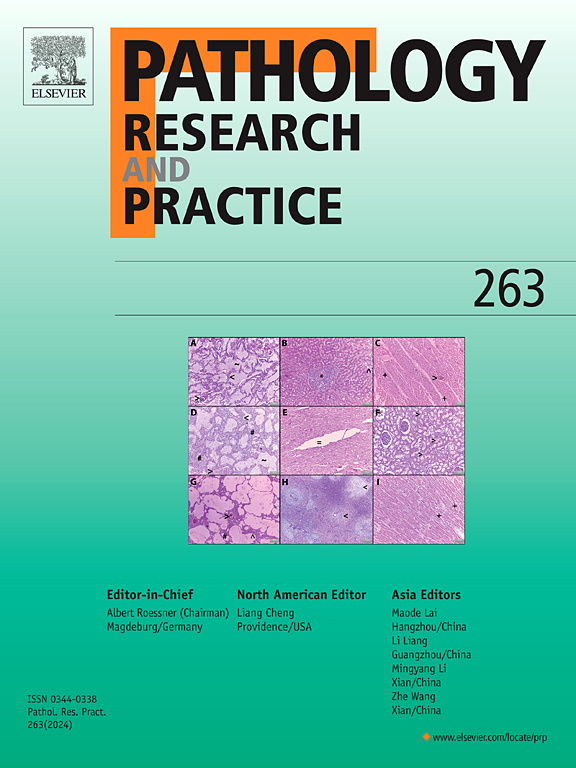Non-coding RNA methylation modifications in ovarian cancer
IF 3.2
4区 医学
Q2 PATHOLOGY
引用次数: 0
Abstract
Ovarian cancer (OC) is a highly heterogeneous gynecological cancer with high mortality rates. Non-coding RNA is a class of transcripts which do not encode proteins, but plays important regulatory roles in gene expression and protein function by targeting specific genes or interacting with proteins. RNA methylation, mainly focused on m6A, m1A, m5C, and m7G, is a common post-transcriptional modification that is essential for regulating various biological processes, such as RNA transcription, splicing, structure, stability, and translation, and has been reported to be involved in the regulation of the development of various human malignancies. Recent scholarly inquiries have posited that methylation alterations occur on ncRNAs, implicating their involvement in the etiology of ovarian cancer. In this review, we summarized four common types of RNA methylation modifications and their associated enzymes, as well as methylated ncRNAs involved in regulating ovarian cancer. We briefly introduced the mechanisms of action of ncRNA methylation in the occurrence, proliferation, immune response, and drug resistance of ovarian cancer as reported currently, and the methylation-related lncRNAs that can be further studied.
卵巢癌中的非编码RNA甲基化修饰
卵巢癌(OC)是一种高异质性、高死亡率的妇科肿瘤。非编码RNA是一类不编码蛋白质,但通过靶向特定基因或与蛋白质相互作用,在基因表达和蛋白质功能中发挥重要调控作用的转录本。RNA甲基化主要集中在m6A、m1A、m5C和m7G上,是一种常见的转录后修饰,对调节RNA转录、剪接、结构、稳定性和翻译等多种生物过程至关重要,并被报道参与调节多种人类恶性肿瘤的发展。最近的学术研究假设甲基化改变发生在ncrna上,暗示它们参与卵巢癌的病因学。在这篇综述中,我们总结了四种常见的RNA甲基化修饰及其相关酶,以及参与调节卵巢癌的甲基化ncrna。我们简要介绍了目前报道的ncRNA甲基化在卵巢癌发生、增殖、免疫反应和耐药中的作用机制,以及有待进一步研究的与甲基化相关的lncrna。
本文章由计算机程序翻译,如有差异,请以英文原文为准。
求助全文
约1分钟内获得全文
求助全文
来源期刊
CiteScore
5.00
自引率
3.60%
发文量
405
审稿时长
24 days
期刊介绍:
Pathology, Research and Practice provides accessible coverage of the most recent developments across the entire field of pathology: Reviews focus on recent progress in pathology, while Comments look at interesting current problems and at hypotheses for future developments in pathology. Original Papers present novel findings on all aspects of general, anatomic and molecular pathology. Rapid Communications inform readers on preliminary findings that may be relevant for further studies and need to be communicated quickly. Teaching Cases look at new aspects or special diagnostic problems of diseases and at case reports relevant for the pathologist''s practice.

 求助内容:
求助内容: 应助结果提醒方式:
应助结果提醒方式:


